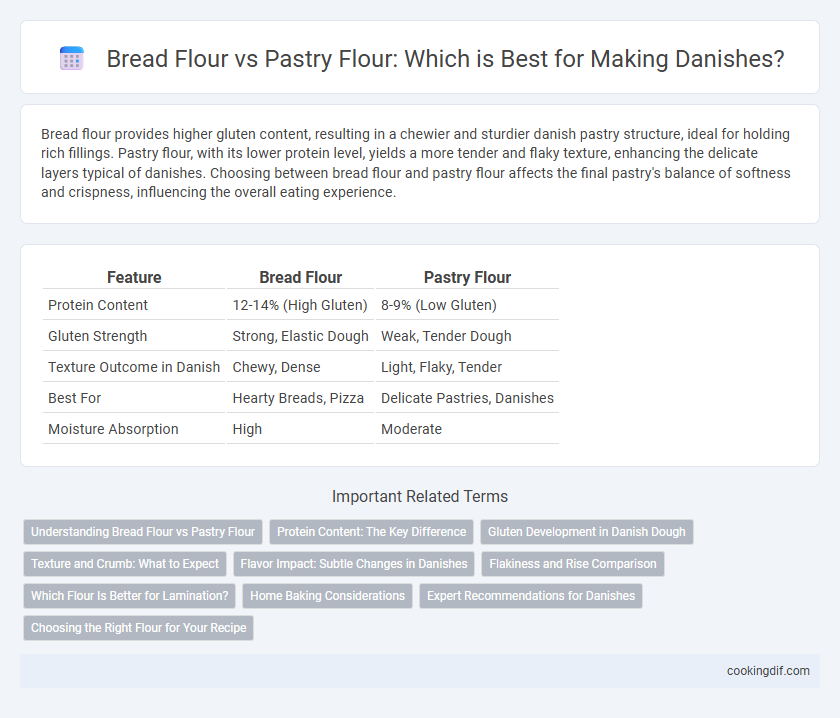Bread flour provides higher gluten content, resulting in a chewier and sturdier danish pastry structure, ideal for holding rich fillings. Pastry flour, with its lower protein level, yields a more tender and flaky texture, enhancing the delicate layers typical of danishes. Choosing between bread flour and pastry flour affects the final pastry's balance of softness and crispness, influencing the overall eating experience.
Table of Comparison
| Feature | Bread Flour | Pastry Flour |
|---|---|---|
| Protein Content | 12-14% (High Gluten) | 8-9% (Low Gluten) |
| Gluten Strength | Strong, Elastic Dough | Weak, Tender Dough |
| Texture Outcome in Danish | Chewy, Dense | Light, Flaky, Tender |
| Best For | Hearty Breads, Pizza | Delicate Pastries, Danishes |
| Moisture Absorption | High | Moderate |
Understanding Bread Flour vs Pastry Flour
Bread flour contains a higher protein content, typically 12-14%, which develops more gluten, resulting in a chewier and denser texture ideal for sturdy bread but less suited for delicate danishes. Pastry flour, with a lower protein content of around 8-9%, produces tender, flaky layers by limiting gluten formation, making it the preferred choice for light and airy pastries like danishes. Choosing pastry flour over bread flour ensures optimal softness and flakiness in danish dough, enhancing the final product's texture and mouthfeel.
Protein Content: The Key Difference
Bread flour contains a higher protein content, typically around 12-14%, which provides more gluten development, resulting in a chewier and sturdier dough ideal for artisan breads. Pastry flour has a lower protein content, usually 8-9%, which produces a tender, flaky texture perfect for delicate danishes and pastries. Choosing the right flour based on protein levels directly affects the dough's texture, with pastry flour yielding softer, more crumbly layers essential for classic Danish pastries.
Gluten Development in Danish Dough
Bread flour contains higher protein content, typically 12-14%, promoting strong gluten development ideal for chewy, structured doughs, but can result in tougher danish pastries if overdeveloped. Pastry flour, with 8-9% protein, produces softer, more tender doughs with less gluten formation, enabling delicate layers and flaky textures characteristic of high-quality danishes. Controlling gluten development in danish dough is crucial, as excessive gluten from bread flour can hinder lamination and pastry flakiness, while pastry flour ensures optimal balance between elasticity and tenderness.
Texture and Crumb: What to Expect
Bread flour's high protein content creates a strong gluten network, resulting in a chewier texture and denser crumb in danishes. Pastry flour, with lower protein levels, produces a tender, flaky texture and a lighter, more delicate crumb ideal for layered pastries. Choosing pastry flour enhances the softness and flakiness that define traditional danishes, while bread flour yields a firmer bite and more structured crumb.
Flavor Impact: Subtle Changes in Danishes
Bread flour, with its higher protein content of around 12-14%, develops more gluten, resulting in a chewier texture and a slightly bolder flavor in danishes. Pastry flour, containing 8-9% protein, yields a tender, flaky crumb that highlights the buttery notes and delicate sweetness typical of danishes. Choosing pastry flour enhances subtle flavor nuances and a softer mouthfeel, while bread flour imparts a heartier taste and denser structure.
Flakiness and Rise Comparison
Pastry flour has a lower protein content (8-9%) compared to bread flour (12-14%), resulting in less gluten formation, which enhances the flakiness and tenderness of danish pastries. Bread flour's higher protein promotes stronger gluten networks, leading to greater rise but a denser, chewier texture that can compromise the delicate layers in danishes. Using pastry flour achieves an optimal balance of rise and flakiness, ensuring light, airy, and flaky danish pastries with well-defined layers.
Which Flour Is Better for Lamination?
Pastry flour, with its lower protein content (7-9%), creates a more tender and delicate crumb ideal for laminated danishes, allowing layers to remain soft and flaky. Bread flour, containing higher protein levels (12-14%), develops stronger gluten, which can result in a chewier texture and more resistance during lamination, sometimes causing less lift and separation of layers. For optimal lamination in danishes, pastry flour generally yields better flake formation and a finer, buttery texture.
Home Baking Considerations
Bread flour, with its higher protein content (12-14%), develops more gluten, providing the structure needed for chewy, sturdy danishes, while pastry flour's lower protein (8-9%) yields a tender, delicate crumb ideal for flaky, light pastries at home. When baking danishes, home bakers seeking crisp layers and softness might prefer pastry flour to avoid toughness caused by excessive gluten formation. Experimenting with flour blends or sifting pastry flour can optimize texture, balancing structure and tenderness in homemade danishes.
Expert Recommendations for Danishes
Experts recommend pastry flour for danishes due to its lower protein content of around 8-9%, which ensures a tender, flaky texture crucial for laminated dough. Bread flour, with its higher protein content of 12-14%, can develop excessive gluten, resulting in a tougher, chewier pastry rather than the desired lightness. For optimal danish layers and delicate crumb, pastry flour remains the preferred choice among professional bakers.
Choosing the Right Flour for Your Recipe
Choosing the right flour for danishes directly impacts their texture and rise, with pastry flour offering a lower protein content (8-9%) ideal for tender, flaky layers. Bread flour, containing higher protein (12-14%), develops more gluten strength, resulting in a chewier, denser pastry that may compromise the delicate crumb of danishes. For optimal lightness and softness in your danishes, pastry flour is preferred to achieve the perfect balance of structure and tenderness.
Bread Flour vs Pastry Flour for danishes Infographic

 cookingdif.com
cookingdif.com